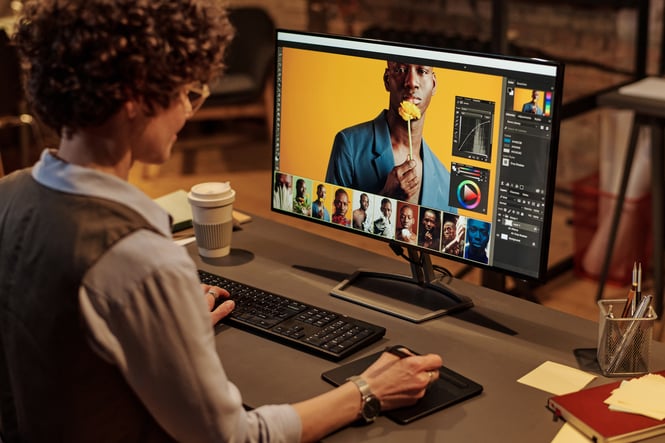A Beginner's Guide to Editing Digital Photos & Videos

Hey there, fellow creators! Welcome to the wonderful world of digital photo and video editing. Whether you're an aspiring photographer, a budding vlogger, or just someone who loves capturing memories, this beginner's guide will help you dive into the exciting realm of image editing. We'll cover the basics of editing, discuss essential editing techniques, and even peek into the future of editing using AI. So, grab your creative hats, and let's get started!
Let’s start with some of the best tools and apps out there to make your photos and videos really pop.
Adobe Photoshop Express: Adobe Photoshop Express is a simplified version of the renowned Adobe Photoshop software. It offers a user-friendly interface, making it perfect for beginners. This app provides a wide range of features such as basic adjustments, filters, cropping, and red-eye removal. With its intuitive controls, you can quickly enhance your photos and experiment with different effects.- VSCO: VSCO is a popular app among photography enthusiasts. It not only offers a variety of filters but also provides advanced editing tools. VSCO's sleek interface and easy-to-use controls allow beginners to transform their photos effortlessly. Additionally, VSCO serves as a creative platform, enabling users to showcase their work and connect with other photographers.
- Snapseed: Snapseed, developed by Google, is a powerful photo editing app suitable for beginners and professionals alike. It offers a wide range of tools and filters to enhance your images. The app's interface is user-friendly, with simple swipe gestures for adjusting brightness, contrast, saturation, and more. Snapseed also provides precise control over selective editing, enabling you to enhance specific areas of your photos.
- iMovie: For beginners in video editing, iMovie is an excellent choice. This app, available on Mac and iOS devices, offers a straightforward and intuitive interface. iMovie allows you to import videos, add transitions, apply filters, and include music or voiceovers. With its drag-and-drop functionality, even those new to video editing can create impressive projects.
- Adobe Premiere Rush: Adobe Premiere Rush is a versatile app designed for both beginners and experienced video editors. It provides a simplified editing workflow without compromising on essential features. The app allows you to edit videos on various devices and provides seamless integration with other Adobe Creative Cloud apps. Adobe Premiere Rush is ideal for beginners who want to explore more advanced video editing techniques.
- Photobucket: Photobucket photo storage and video storage is a cloud-based platform that offers photo and video hosting, sharing, and editing capabilities. While it may not be as well-known as some other options, Photobucket offers several useful features for beginners. It allows you to upload and store your media in the cloud, organize them into albums, and share them with others. The editing tools in Photobucket enable basic adjustments like cropping, rotating, and applying filters, making it a user-friendly option for beginners. Photobucket's strength lies in its simplicity and accessibility. It provides a hassle-free way to store, organize, and share your visual content. Additionally, the built-in editing tools make it convenient for beginners who don't require advanced features but still want to enhance their photos. Photobucket's user-friendly interface and focus on essential editing functions make it an excellent option for those just starting their journey in digital photo editing.

Next, some of the basics of editing you can use to bring your photos and videos to life.
- Understanding the Basics: Before diving into editing techniques, it's crucial to familiarize yourself with the basics. Learn how to navigate your chosen photo or video editing software, as each program has its own interface and tools. Familiarize yourself with terms like brightness, contrast, saturation, and cropping, as these will be the foundation of your editing process.
- Adjusting Brightness and Contrast: Brightness and contrast are fundamental elements that greatly impact the overall appearance of your visuals. Brightness refers to the overall lightness or darkness of the image, while contrast determines the difference between the darkest and lightest areas. To make your photos or videos look more professional, experiment with these adjustments to find the right balance. Generally, increasing brightness can add a vibrant feel, while adjusting contrast can enhance details and make your visuals more dynamic.
- Enhancing Saturation: Saturation refers to the intensity of colors in an image or video. Adjusting saturation can make your visuals look more vibrant or subdued, depending on your desired effect. Boosting saturation can make colors pop and add energy, but be careful not to overdo it, as it may result in unrealistic and artificial-looking visuals. Finding a balance that enhances the colors without making them appear unnatural is the key.
- Cropping and Composition: Cropping is the process of removing unwanted elements or adjusting the framing of your visuals. It allows you to focus on the most important parts and improve the composition. To make your photos or videos look more professional, consider the rule of thirds, where you align key elements along imaginary lines that divide the frame into thirds. This technique often leads to more visually appealing compositions.
- Use Filters and Presets: Many photo and video editing applications offer pre-designed filters and presets that can instantly enhance your visuals. These filters apply a combination of adjustments to achieve specific styles or moods, such as vintage, black and white, or cinematic looks. Experiment with different filters and presets to find the ones that align with your vision and make your photos or videos look professional with a single click.
- Take Advantage of Basic Retouching: Sometimes, minor retouching can significantly improve the overall quality of your visuals. Simple edits like removing blemishes, adjusting skin tones, or reducing distractions can go a long way in making your photos or videos look more polished. However, remember to exercise caution and maintain the natural appearance of your subjects.

How to use AI to take my photos & video to the next levels.
In recent years, the world has witnessed remarkable advancements in artificial intelligence (AI) technology, transforming various industries. One such domain profoundly impacted by AI is the editing of digital photos and videos. AI-powered editing tools are revolutionizing the way we enhance, retouch, and manipulate visual content. Here’s a look into the future that’s happening now!
- Automated Enhancements: AI algorithms are becoming increasingly adept at analyzing and understanding visual content. With this capability, editing tools can automatically enhance photos and videos by adjusting brightness, contrast, saturation, and other parameters to achieve optimal results. This saves time and effort for content creators, enabling them to focus more on their artistic vision rather than technical adjustments.
- Intelligent Object Removal: Gone are the days of painstakingly removing unwanted objects or people from photos or videos frame by frame. AI-powered editing tools are now capable of intelligently identifying and removing unwanted elements automatically. By leveraging advanced computer vision techniques, AI algorithms can seamlessly fill in the gaps left by removed objects, resulting in smooth and natural-looking edits.
- Style Transfer and Filters: AI allows for unprecedented creativity in editing by enabling style transfer and the application of artistic filters. With deep learning algorithms, images and videos can be transformed to resemble various artistic styles, mimicking famous painters or adding unique visual effects. This opens up new avenues for self-expression and enables content creators to experiment with different aesthetics effortlessly.
- Facial Recognition and Retouching: AI-driven facial recognition technology has significantly improved the way we retouch portraits. Facial detection algorithms can identify specific facial features, such as eyes, nose, and mouth, enabling precise adjustments and retouching. From removing blemishes to enhancing skin tones and even altering facial expressions, AI is providing powerful tools to achieve professional-grade results.
- Video Editing Automation: Video editing can be a time-consuming and complex task, involving cutting, merging, and synchronizing multiple clips. AI algorithms can automate many of these processes, intelligently analyzing footage to identify key moments, transitions, and even adding appropriate background music. This streamlines the video editing workflow and allows creators to produce high-quality content more efficiently.
- Deepfake Detection and Authentication: While AI has brought numerous benefits to the field of editing, it has also raised concerns regarding deepfakes—manipulated content that appears deceptively real. In response, AI researchers are developing advanced algorithms capable of detecting deepfakes and verifying the authenticity of digital media. These techniques will play a crucial role in combating misinformation and ensuring the integrity of visual content.
- Collaborative Editing and Crowd Intelligence: AI-powered editing platforms have the potential to facilitate collaborative editing and tap into the wisdom of the crowd. By leveraging collective intelligence, multiple editors can work together in real-time, sharing ideas, suggesting improvements, and collectively refining visual content. This collaborative approach enhances the creative process and leads to richer and more diverse outcomes.
Congratulations, my creative comrade! You've successfully dipped your toes into the exciting world of image editing with this handy-dandy beginner’s guide. By mastering the basics of editing, you can now transform your raw footage into captivating visuals. Remember, editing is an art form that evolves with your skills and creativity. So, keep experimenting, learning from others, and always trust your artistic instincts. Whether you're an amateur or a future editing maestro, have fun, and let your imagination run wild! If you'd like to store your photos, Photobucket has your photo storage needs covered.
Happy editing!
